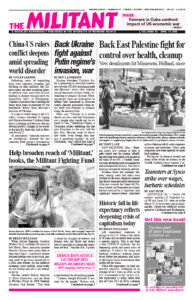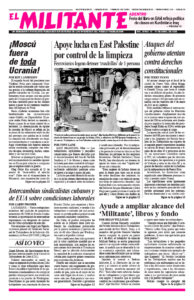Following years of expanding their state capitalist economy and building up their military, the Chinese rulers are now asserting greater political clout, especially in Asia, leading to sharper tensions with the imperialist rulers in Washington. Conflicts that have been building for years have been accelerated by the worldwide fallout from Moscow’s invasion of Ukraine.
In a not-so-veiled swipe at the U.S. rulers, Chinese President Xi Jinping told Russian President Vladimir Putin that it is Beijing and Moscow that are driving historic changes in the world, at the end of a three day visit to Moscow March 22.
Xi proclaimed “common interests are multiplying” between the two countries. Both signed a statement on the war in Ukraine making no mention of Moscow’s violation of Ukrainian sovereignty, instead blaming the U.S.-led NATO alliance.
Chinese officials have begun discussing their “peace” plan to end the war with governments in Europe that are allied with Washington. Spanish Prime Minister Pedro Sánchez traveled to Beijing and urged Xi to talk to Ukrainian President Volodymyr Zelensky. French President Emmanuel Macron and Ursula von der Leyen, the European Commission president, plan to visit Beijing this week.
Ties with Moscow
For Xi, Beijing’s ties with Moscow are foremost about countering what he calls the “all-round containment, encirclement and suppression of China” by Washington. Russia’s capitalist class finds itself in a weaker position a year into the war and Putin has no choice but to play second fiddle.
Over decades the massive expansion of Chinese exports led Beijing to launch its Belt and Road Initiative, seeking greater profits and control over trade routes as it drew capitalist rivals and semicolonial regimes more closely into its orbit. As a result, it also seeks to advance its political influence. In March the Chinese government brokered a deal between the governments of Iran and Saudi Arabia, ending a seven-year rift in their relations. Both agreed to seek an end to the war in Yemen, where they back opposite sides.
Last month the Honduran government established diplomatic relations with Beijing and cut its ties with the government of Taiwan. Honduran Foreign Minister Eduardo Enrique told the Japan Times the decision was made in part because the Honduran government was “up to its neck” in debt and needed loans from China.
Xi also hopes to rally support at home as the worldwide capitalist crisis continues to batter workers’ living standards. City authorities are buried in debt after exhausting funds to comply with pandemic testing and lockdown rules. Some 31 provincial governments owed around $5.1 trillion at the end of 2022.
Over five years, authorities in Shangqiu, a city of 7 million, ordered the building of 114 miles of rail, two airports and three new highways. But in February, the city’s bus operator announced it would have to suspend service. The company hadn’t paid its employees for months. Other city administrations are drawing up plans to cut spending on education, health care and public services.
Protests mount in China
Since January thousands of people, including many retirees, have taken to the streets in Wuhan and other cities to demand authorities reverse cuts to medical benefits.
The Chinese rulers’ expansionist course is bumping into problems elsewhere. Many of its huge Belt and Road projects have left governments with debts they can’t pay. Under the program the Chinese rulers eclipsed the World Bank as the largest lender to developing countries. Now around a quarter of the roughly $1 trillion of Belt and Road financing is being used to extend further loans, putting these governments in even deeper debt, as Beijing tries to rescue its own banking system.
In addition, many of the projects are plagued with construction flaws. Thousands of cracks have emerged in the Chinese-built $2.7 billion Coca Codo Sinclair hydroelectric plant in Ecuador, the country’s biggest source of power.
Beijing has increased its military budget to $300 billion, up sharply from just $22 billion in 2000. In recent years the Chinese air force has flown hundreds of sorties near Taiwan. The Taiwanese government says the flights are designed to probe and exhaust the island’s defenses.
Last August, Beijing responded to the visit of then-House Speaker Nancy Pelosi to Taiwan by launching missiles, deploying warships in the Taiwan Straits and simulating a blockade of the island. On April 3, Beijing warned House Speaker Kevin McCarthy not to go ahead with a planned meeting with Taiwan President Tsai Ing-wen when she visits the U.S.
Beijing’s war machine still pales in comparison to Washington’s, with its $800 billion military budget, its stockpiles and its control of 750 bases in at least 80 countries worldwide. U.S. officials are taking steps to amass a giant weapons stockpile in Taiwan aimed at heading off an invasion by Beijing.
Washington’s allies in the Asia-Pacific region are also rearming and solidifying their collaboration. The Japanese government recently initiated its biggest armaments program since World War II, raising military spending by 60% over the next five years. On March 13, the Australian rulers unveiled a $200 billion plan to build nuclear-propelled submarines with the governments of the U.S. and U.K.
In February, U.S. airmen refueled Japanese fighter jets during a joint military exercise on Tinian island, in the Northern Marianas Islands, just north of Guam. Tinian was the launch point when the U.S. rulers dropped nuclear bombs on Hiroshima and Nagasaki in 1945. “We’re not concerned with the past, we are concerned with the future,” said Col. Inadome Satoru, commander of Japan’s Ninth Air Wing Flight Group.

